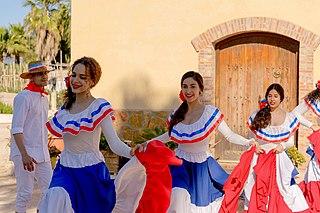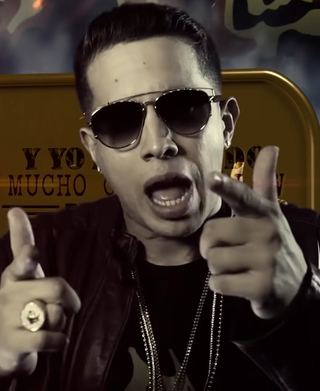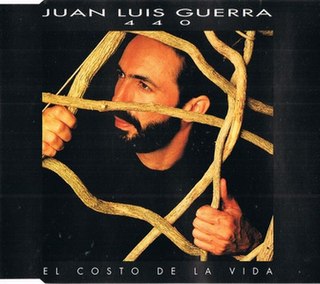
The music of the Dominican Republic is primarily influenced by Western European music, with Sub-Saharan African and native Taino influences. The Dominican Republic is mainly known for its merengue and bachata music, both of which are the most famous styles of music in the Dominican Republic, and have been exported and popularized around the world.

The Music of Puerto Rico has evolved as a heterogeneous and dynamic product of diverse cultural resources. The most conspicuous musical sources of Puerto Rico have primarily included European, Indigenous, and African influences, although many aspects of Puerto Rican music reflect origins elsewhere in the Caribbean. Puerto Rican music culture today comprises a wide and rich variety of genres, ranging from essentially native genres such as bomba, danza, and plena to more recent hybrid genres such as salsa, Latin trap and reggaeton. Broadly conceived, the realm of "Puerto Rican music" should naturally comprise the music culture of the millions of people of Puerto Rican descent who have lived in the United States, especially in New York City. Their music, from salsa to the boleros of Rafael Hernández, cannot be separated from the music culture of Puerto Rico itself.
Panama is a Central American country, inhabited mostly by mestizos. The music of Panama is heavily based on the folk music of Spain, particularly that of Andalusia and was influenced first by the indigenous populations of Kunas, Teribes, Ngobe Bugle and others, and then by the black population who were brought over, first as slaves from Africa, between the 16th century and the 19th century, and then voluntarily to work on the Panamanian Railroad and Canal projects between the 1840s and 1914.

Merengue is a type of music and dance originating in the Dominican Republic, which has become a very popular genre throughout Latin America, and also in several major cities in the United States with Latino communities. Merengue was inscribed on November 30, 2016 in the representative list of the Intangible Cultural Heritage of Humanity of UNESCO.

Bachata is a genre of music that originated in the Dominican Republic in the 20th century. It contains elements of European, indigenous Taino and African musical elements, representing the cultural diversity of the Dominican population.

Juan de Dios Ventura Soriano, better known as Johnny Ventura nicknamed El Caballo Mayor, was a Dominican singer and band leader of merengue and salsa.

Proyecto Uno is a Dominican-American hip hop/Merengue house group which helped popularize a style of music which blends merengue with techno, dancehall, reggae and hip-hop/rap music. The band was founded in New York City's East Side in 1989 by Nelson Zapata and managed by Porfirio "Popi" Piña. Originally formed as traditional merengue band, Proyecto Uno received recognition in the 1990s, the group won Billboard Latin Music Awards, Premios Lo Nuestro and was nominated for an Emmy award. The current members are Nelson Zapata, Kid G and Paolo Tondo. The manager of the group currently is Rafael Zapata III.

2 in a Room was an American hip hop, freestyle and hip house duo. The group, active between 1987 and 1995, consisted of rapper Rafael "Dose" Vargas and producer/remixer Roger "Rog Nice" Pauletta.
Latin house is an electronic dance music genre that combines house and Latin American music, such as that of Puerto Rican, Cuban, Dominican,

Magic Juan is an American merengue and hip hop artist. He was the lead singer and rapper of Dominican-American merengue group Proyecto Uno. The group gain huge success with hits like "Brinca", "El Tiburon", "25 Horas", among others. Later on he pursued a solo career.
740 Boyz is a Dominican-American dance music group founded in 1991, by Winston Rosa a.k.a. Big Win from New York City.

Rafael Castillo Torres, known professionally as De la Ghetto, is an American singer, rapper and songwriter. He was a member of the duo Arcángel & De la Ghetto.

Fogaraté! is the seventh album of the famous Dominican songwriter and musician Juan Luis Guerra. It was released on July 19, 1994. The album mixed a variety of music genres including rural and flolklroic rots of merengue called "Perico Ripao" with elements of African soukus music and Tropical Music such as Reggae with the collaboration of African guitarist Diblo Dibala and Dominican accordionist Francisco Ulloa, along with Son, Bachata and Salsa. Also, the album features a particular, bachata-styled adaptation of the Lacrimosa movement from Mozart's Requiem Mass in D Minor and Guerra's first song fully in English "July 19". Exploring lyrics and themes about magical realism of Latin American literature and commenting on the politics of the Caribbean, for many fans and critics, Fogaraté! is one of his most musically complex album.
Alternative reggaeton is a subgenre of reggaeton that emerged from the reggaeton movement as a reaction to its repetitive and monotone dembow rhythm, and the predominant stereotypical gangsta content that became predictable. The result was a complex sound derived from world sounds, mainly rooted in other Latin American music based genres such as bomba, plena, salsa, bachata, merengue, cumbia, tango and other foreign influenced music such as alternative rock, rock en español and Latin alternative. Mixed with thoughtful lyricism guided by an anti-colonialism discourse, Latin American sociopolitical content, and racial pride, it gave listeners a smooth blend of danceable rhythms and intellectual dialogue.
Merenhouse, merenrap or electronic merengue,Mambo o Mambo de Calle is a style of Dominican merengue music formed by blending with dancehall reggae and hip hop. The mix of Latin music, house music and dancehall started in NYC in the late 1980s.
Sandy & Papo MC, Sandy MC & MC Papo or simply Sandy & Papo, was a duo of merengue and hip hop music, with temporary residence in Venezuela. Its members were Sandy Carriello "Sandy MC" and Luis Deschamps "MC Papo", both from the Dominican Republic. The duo was created by Nelson Zapata and Pavel de Jesus, after attending an audition for Proyecto Uno.

Vicente García Guillén is a Dominican musician, singer and composer. He is the former lead singer of the Dominican alternative rock band Calor Urbano, which he left in 2010 to pursue a solo career. Garcia has collaborated in concerts with renowned artists such as Juan Luis Guerra, Alejandro Sanz, Cultura Profetica, Juanes, Ximena Sariñana and Maná among others. He has won three Latin Grammy awards including Best New Artist in 2017.

Máxima Alerta is a Cuban-American fusion music band known for its merging of Cuban reggaeton, or Cubaton, with traditional Cuban music and other Latin musical genres.
Urbano music or Latin urban is a transnational umbrella category including many different genres and styles. As an umbrella term it includes reggaeton, dancehall, dembow, urban champeta, funk carioca and Latin hip hop. The commercial breakthrough of this music took place in 2017. Artists in style collaborate transnationally and may originate from the United States, Colombia, Cuba, the Dominican Republic, Panama, Venezuela or other Spanish-speaking nations, as well as Portuguese-speaking Brazil.

"El Costo de la Vida" is a song by Dominican Republic singer-songwriter Juan Luis Guerra from his sixth studio album, Areíto (1992). The song was released as the album's third single in 1992 by Karen Records. It is a Spanish-language adaptation of soukous song "Kimia Eve" composed by Diblo Dibala. The song features Dibala on the guitar and is performed by Guerra as a merengue number. The lyrics to the song provides a social commentary to the rising cost of living, while the artist denounces the dislevel of socioeconomics as well as political corruptions in Latin America. He also references the racial identities of Latin America.













